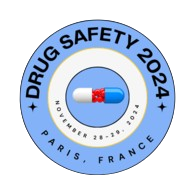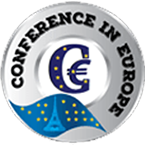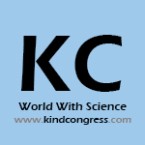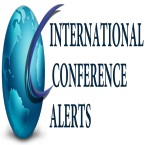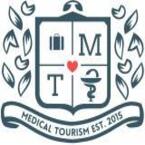Recommended Global Pharmaceutical Sciences Webinars & Conferences
Asia Pacific & Middle East
Canada
Drug Safety 2024
- About Conference
- Why To Attend
- Who Should Attend
- Participation And Benefits
- Session Tracks
- Market Analysis
About Conference
The "17th International Conference on Pharmaceutics and Drug Safety" will be held on November 28-29, 2024, in Paris, France.
Pharmaceutics conference will bring together major figures in the global pharmaceutics and Drug Safety industry from the fields of Pharmacy epidemiology, data analytics, pharmacovigilance, and drug safety. Examine benefit-risk management tactics, patient-centric approaches, and the use of big data and AI in pharmacovigilance. Also, talk about how to deal with social media difficulties and international drug safety legislation.
Why To Attend
Attending a Pharmaceutics and Drug Safety conference can be highly beneficial for professionals and students in the pharmaceutical and healthcare fields. Here are some compelling reasons to attend such a conference:
- Networking Opportunities: Connect with professionals, researchers, and experts from around the world.
- Latest Research: Gain insights into the latest advancements and research in pharmaceutics and drug safety.
- Expert Speakers: Learn from keynote speakers who are leaders in the field.
- Workshops and Tutorials: Participate in interactive sessions to enhance your practical knowledge and skills.
- Panel Discussions: Engage in discussions on current challenges and future directions in pharmaceutics and drug safety.
- Poster Sessions: View and discuss posters presented by researchers on innovative studies and findings.
- Exhibitions: Explore the latest products, technologies, and services offered by industry vendors.
- Collaborative Opportunities: Discover potential collaborators for future research projects and studies.
- Professional Development: Enhance your career by staying updated with the latest trends and best practices.
- Case Studies: Learn from real-world case studies presented by industry experts.
- Regulatory Insights: Gain knowledge about current and upcoming regulatory requirements and guidelines.
- Clinical Trials: Understand the latest developments in clinical trials and their implications for drug safety.
- Patient Safety: Learn strategies to improve patient safety and minimize adverse drug reactions.
- Drug Development: Discover new methodologies and technologies in drug development.
- Global Perspectives: Gain a global perspective on pharmaceutics and drug safety practices.
- Funding Opportunities: Identify potential funding sources for your research projects.
- Academic Advancement: Present your own research and receive feedback from peers and experts.
- Continuing Education: Earn continuing education credits to maintain professional certifications.
- Innovation Showcase: Witness innovative solutions and breakthroughs in pharmaceutics.
- Inspiration: Get inspired by the groundbreaking work being done in the field and motivate your own research and professional endeavors.
Who Should Attend
The Pharmaceutics and Drug Safety conference is relevant for a broad range of professionals and stakeholders in the pharmaceutical and healthcare industries. Here are some key groups who should consider attending:
- Pharmaceutical Scientists: Those involved in research, development, and manufacturing of pharmaceuticals.
- Drug Safety Professionals: Specialists focused on ensuring the safety of drugs throughout their lifecycle.
- Regulatory Affairs Experts: Individuals involved in navigating regulatory requirements for drug approval and compliance.
- Clinical Pharmacologists: Professionals studying the effects of drugs on humans.
- Pharmacy Practitioners: Pharmacists interested in the latest advancements and safety protocols.
- Biopharmaceutical Researchers: Scientists exploring biologically derived pharmaceuticals.
- Drug Formulation Experts: Specialists in designing drug formulations for optimal delivery.
- Quality Assurance and Control Personnel: Professionals ensuring pharmaceutical products meet quality standards.
- Chemical Engineers: Experts in chemical processes involved in drug manufacturing.
- Medical Professionals: Doctors and healthcare providers interested in new treatments and safety considerations.
- Academic Researchers: Scholars studying pharmaceutics and drug safety.
- Government Officials: Regulators overseeing drug safety and approval processes.
- Clinical Trial Managers: Professionals managing clinical trials to evaluate drug safety and efficacy.
- Pharmacokineticists: Researchers studying drug absorption, distribution, metabolism, and excretion.
- Toxicologists: Scientists investigating the adverse effects of drugs and chemicals.
- Bioanalytical Chemists: Experts analyzing drugs and metabolites in biological samples.
- Patient Safety Advocates: Individuals focusing on ensuring drug safety for patients.
- Ethical Review Board Members: Professionals overseeing the ethical aspects of drug trials.
- Health Economists: Researchers studying the economic impact of pharmaceuticals and safety considerations.
- Pharmacogeneticists: Specialists studying how genetics influence drug responses.
- Public Health Officials: Experts concerned with population-level drug safety and efficacy.
- Veterinary Pharmacists: Professionals specializing in medications for animals.
- Pharmaceutical Engineers: Engineers involved in designing pharmaceutical manufacturing processes.
- Pharmacovigilance Professionals: Specialists monitoring and assessing drug safety post-marketing.
- Drug Delivery Researchers: Scientists developing innovative methods for drug delivery.
- Biomedical Scientists: Researchers investigating the biological mechanisms of drug action.
- Infectious Disease Specialists: Experts focusing on drugs used in the treatment of infectious diseases.
- Healthcare Administrators: Managers overseeing drug procurement and safety protocols in healthcare facilities.
- Clinical Research Coordinators: Professionals coordinating clinical trials and ensuring adherence to safety protocols.
- Medical Writers and Communicators: Individuals translating complex drug safety information for broader audiences.
- Pharmaceutical Consultants: Advisors providing expertise in drug development and safety strategies.
- Pharmacy Students: Students interested in learning about emerging trends in pharmaceutics and drug safety.
- Chemists: Researchers and professionals involved in drug discovery and analysis.
- Biotechnologists: Specialists utilizing biological systems for pharmaceutical development.
- Data Scientists: Experts analyzing large datasets related to drug safety and efficacy.
- Pharmacoeconomists: Economists studying the cost-effectiveness of pharmaceuticals.
- Bioethicists: Scholars exploring the ethical implications of pharmaceutical research and drug use.
- Medical Device Developers: Professionals integrating drugs into medical devices for safer delivery.
- Environmental Health Scientists: Researchers studying the environmental impact of pharmaceuticals.
- Health Technology Assessors: Experts evaluating the benefits and risks of new health technologies, including pharmaceuticals.
Participation And Benefits
-
Our extensive online advertising attracts 30000+ users and 50000+ views to our library of abstracts, driving researchers and speakers to our conference.
-
Meet hundreds of like-minded experts leading the Drug Safety 2024 and share ideas.
-
All conference participants will have a different reason to participate in one-on-one meetings with eminent speakers and famous keynote speakers.
-
In our keynote sessions you will have a wonderful opportunity to hear what the world's experts are learning from the world's most influential researchers in the fields of pharmaceutics and drug safety
-
Drug Safety 2024 Conference Schedule, you'll gain experience and expertise in crafting strategic gifts that are worth its weight golfing, creating an impressive array of recognized professionals.
- Nomination for Best Poster Award, Outstanding Young Researcher Award, Benefits of group registration.
Participation Benefits for Speaker
-
Worldwide appreciation of the research design.
-
Receive credit for professional development.
-
Explore the latest analysis.
-
Learn a transition beyond your area of ​​interest to learn more about new topics and studies away from your core theme of the Drug Safety 2024.
-
We have exclusive networking, learning and integration in a single package.
Participation Benefits for the Delegate
-
Professional development - improving understanding and knowledge.
-
Attendance at conferences rejuvenates and energizes delegates.
-
Your participation in our conference will help with a new approach and ideology that can be used to broaden the results of businesses or industries.
-
Opportunities for the Drug Safety 2024 for researchers and experts in the same field to meet and exchange new ideas through a physical conference.
Participation Benefits for the Sponsor / Exhibitor
-
Exposure to international environment will increase the chances of new companies of pharmaceutics.
-
Opportunity to showcase your company's latest technologies, new products or serve your business to a wide range of international participants.
-
Building a successful company takes a lot of time, effort and drive, so it is always good to have a network of the colleagues and associates who have drawn energy from individuals who share a similar drive and purpose.
-
Conferences in Drug Safety provide opportunities for greater focus and reflection that can help you take your company to the next step.
- Benchmarking key organization plans.
Session Tracks
Track 1: Analyses and Quality Control for Pharmaceuticals
Track 2: Biopharmaceuticals, Biomolecules, and Therapeutics
Track 3:Biotechnology and Microbiology in Pharmaceuticals
Track 4: Cellular Targeting and subcellular Delivery
Track 5: Delivery of Medicine via Inhalation
Track 6: Development and Production of Pharmaceutical Products
Track 7: Drug Delivery Technology and Vaccine Design
Track 8: Drug Delivery Using Peptides and Proteins
Track 9: Drug Research and Evaluation
Track 10: Drug Safety
Track 11: Intellectual property rights and regulatory issues
Track 12: Modern drug delivery techniques
Track 13: New Advances in Drug Delivery Systems
Track 14: Pharmaceuticals and Drug Delivery Systems Using Nanotechnology
Track 15: Pharmacogenomics
Track 16: Pharmacology
Track 17: Preformulation Research
Track 18: Radiation-based medicines and biotherapy
Track 19: Research and development in pharmaceuticals
Track 20: Safety of drugs and pharmacovigilance
Track 21:Technologies for Formulation
Track 22: The BBB for drug delivery
Track 23 : Therapeutic Drug Transporters
Market Analysis
A product who’s potential reach and market penetration abilities can be verified by pharmaceutical market research studies. It is used by investors to value pharmaceutical businesses and the products in their pipelines. These businesses make use of it to keep an eye on the competition, spot future unmet requirements, and value their goods. With the help of PMRA, donors and grant makers can find pharmaceuticals that are being developed to treat particular diseases as well as their potential to find a cure for those diseases. Pharmaceutical companies required to consider a product's potential, which is mostly based on the number of patients who have the indication that the drug is approved to treat. If other medications are currently authorised to treat that condition, a new medication must significantly outperform other medications to justify the expense of its research.
To avoid having to compete with the outcomes of already-approved medicines, many pharmaceutical companies will first test a product to treat a rare indication with none now available. Investors looking for stocks that give high returns on investment but having higher than average risk are very interested in the pharmaceutical industry. They utilise PMRA to calculate the potential profits a pharmaceutical business would see if the Food and Drug Administration (FDA) approves all of its upcoming drugs. Then, the revenue potential is compared to the market capitalization and stock price of the business. The items must first pass FDA inspection before earning doctors' trust in order for this income potential to materialise. In order to find the right items and businesses to support, grant providers and philanthropic non-profit organisations can use PMRA. Additionally, the PMRA is used to assess treatment gaps and find goods with the potential therapeutic benefits. The number of patients who can be treated with a treatment in development, the efficacy of the outcomes, and how soon the drug will be available on the market are all factors used by grant providers to make these decisions.
They can also decide if it can be tested on individuals who have the kind of indications they do. Pharmaceutical sciences market research and medication development Hong Kong, China's Bernard M. Y. Cheung University According to a recent Pharmaceutical industry research report by The Business Research Company, the overall pharmaceuticals market in the world had a value of $934.8 billion in 2022 and would increase to $1170 billion in 2021, at a rate of 5.8%. Although that is a faster rate than the 5.2% for the years prior to 2017, this is slower than the growth rates of the other major healthcare segments, medical equipment and healthcare services. Healthcare as a whole is expanding at a rate of over 7% each year. The launch of new drugs has slowed, and the businesses decreased their R&D investment, which helps to explain that why the Pharmaceutical market is currently growing at a relatively moderate rate. For instance, Pfizer has discontinued its Alzheimer's research programme, while AstraZeneca and GSK have scaled back, despite the enormous promise for any novel, safe, and effective medicine to treat the condition. The development of a new medication costs an average of $2 billion, and big pharma companies' returns on investment are declining, going from 10.1% annually in 2010 to 3.2% annually in 2022. according to Deloitte's are preventing the introduction of expensive new breakthrough pharmaceuticals like those that bolstered the market in previous years. Instead, the current growing global ageing population is fulfilling demand for long-term therapies for chronic diseases and was improving access to healthcare in emerging economies, which are both driving development in the pharmaceutical business.
The size of the pharmaceutical market is influenced by a number of factors, including the prevalence of diseases, the cost of medications, consumer attitudes, governmental regulations, and certain supply-side factors:
• Population size, age, genetics, and behaviour are all connected to illness prevalence (infectious disease incidence is lower where sanitation practises are better; sedentary lifestyles also encourage chronic disease).
• Both medicine pricing and affordability are influenced by income.
• Consumer attitudes range from a readiness to adopt complementary therapies to a mistrust of drug use.
• Policies of the government (and insurance companies) have an impact on who pays for reimbursement. Regulation is determined by other laws, which might be a big obstacle for the introduction of new drugs.
• Access to a suitable therapy, which may depend on quantity, as in an epidemic, is a key supply-side factor.
• The growth of the healthcare market, where medications play a significant role, is being influenced by current and future changes in political, economic, social, technological, legal, and environmental issues. The growth of the healthcare industry is fueled by the following factors:
• In the USA, taxes and drug costs have been decreased.
• China and India's GDP growth rates of around 6%
In R&D, industrialised data services have been made it possible to use clinical trial data in trial simulations. In the USA, regulatory hurdles for new treatments have been lowered as compared to previous. In high-population cities, pollution levels are high, which increases the prevalence of illnesses like asthma.
Health care spending per person is anticipated to increase from $1137 in 2017 to $1427 in 2021 as a result.
Restrictions and Drivers in the Pharmaceutical Market
The launch of significant new drugs has slowed, and businesses are limiting their expenditure in R&D, which is one explanation for the pharmaceutical market's current growth's relative sluggishness. For instance, Pfizer has discontinued their Alzheimer's research programme, while AstraZeneca and GSK have decrease their efforts despite the enormous potential for any novel, safe, and effective medicine to treat the condition. High failure rates, the $2 billion average cost of developing a new drug, and declining returns on investment (which, according to Deloitte's, fell from 10.1% a year in 2010 to 3.2% in 2017 for the big pharma companies) are delaying the introduction of pricey new breakthrough drugs like those that boosted the market in earlier years. Instead, the growing global ageing population is fueling demand for long-term therapies for chronic diseases and improving access to healthcare in emerging economies, which are alsodriving development in the pharmaceutical business.
Pharma Markets' Changing Geography
Although Asia Pacific has surpassed Western Europe as the second largest region, North America and Western Europe still make up 56% of the worldwide market due to growth over the past few decades. The introduction of low-cost generics helps to made medications more accessible, which has spurred growth in the Asia Pacific region. Other reasons that assist expansion in the Asia-Pacific region include the region's rising GDP per capita, government healthcare initiatives, and fast urbanisation, which puts pharmacies and doctors' offices within easy reach of expanding people. Up until 2021, Asia Pacific pharmaceutical sales will increase by 8.4% annually.
Important Pharmaceutical Market Segments
Musculoskeletal medications have the largest pharmaceutical market in the world. Treatments for conditions such rheumatoid and osteoarthritis, osteoporosis, carpal tunnel syndrome, tendonitis, rotator cuff tears, muscular dystrophy, myasthenia gravis, lupus erythematosus, and others are available. Major medications in this category include Felden, Dolonex, Piroxicam Pfizer, and Piroxicam Glaxo. In 2017, the market category made about 14% of the overall global market. The second, third, and fourth largest markets are for anti-infective, cardiovascular, and cancer medications.
The pharmaceutical market had experienced the quickest growth until 2021 in the area of drugs for the treatment of various diseases of the thyroid and pituitary glands as well as metabolic disorders like diabetes. Despite a recent rise of 11.8%, this market category will increase to develop at a rate of 9% per year in the future and will hold the fifth-largest market share.
With a market value of over $85 billion in 2017, anti-diabetic medication is the largest sub segment of the global pharmaceutical market. Anti- hypertensives and anti-virals are the next two most valuable segments. The fastest-growing sub segments include medications of the less common diseases, including thyroid, skin, and ovarian cancer. The US Federal Drug Administration has been permitted a less stringent regulatory process and lower endpoint benchmark for malignant disease treatments, which is accelerating the rate of innovation.
Top Pharmaceutical Companies & the Competitive Environment
Pharmaceutical medications are governed by a plethora of laws and rules that address patenting, testing, safety, efficacy, and marketing. These laws and rules also have an impact on the market's size and growth rates. These would be entry-level impediments for small businesses, along with the substantial R&D expenses that are related to developing novel medicinal solutions. Pharmaceutical firms do, however, manufacture both branded and generic medications. For smaller players, generics, that are copies of medications whose patents have been expired, present opportunity. They are gaining market share, especially in poorer nations where the government is promoting their manufacturing to increase access to less expensive medical care.
Top pharmaceutical companies on the market include:
• Novartis
• Sanofi
• Pfizer
• Hoffman-La Roche
• Gilead
To Collaborate Scientific Professionals around the World
Conference Date November 28-29, 2024
Speaker Opportunity
Useful Links
Past Conference Report
Supported By
All accepted abstracts will be published in respective Conference Series International Journals.
Abstracts will be provided with Digital Object Identifier by
